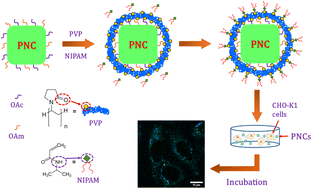Highly water-stable, luminescent, and monodisperse polymer-coated CsPbBr3 nanocrystals for imaging in living cells with better sensitivity†
Abstract
Recently, CsPbX3 (X= Cl, Br, I) nanocrystals (NCs) have evolved as a potential contender for various optoelectronic applications due to some of their excellent photophysical properties. Their superior non-linear optical properties enable them to take part in bioimaging applications due to their longer penetration depth and less scattering effect in living cells. However, the poor stability of perovskite NCs in aqueous media still remains a great challenge for practical usage. Comparatively stable silica-coated NCs have a tendency to agglomerate among other NCs and transform into bigger particles. Such big particles clog the inside of narrow channels during the uptake and can't effectively reach the targeted cells. To tackle such issues, we introduce a fast and reproducible synthesis process of CsPbBr3 NCs that are coated with different long-chained organic ligands/polymers and compared their photophysical properties. Among them, polyvinylpyrrolidone (PVP) encapsulated NCs are highly luminescent in the green spectral region and showed a maximum photoluminescence quantum yield (PLQY) of up to 84%. The incorporation of n-isopropyl acrylamide (NIPAM) along with PVP further improves the stability of the PVP-coated NCs against heat and moisture. These NCs exhibit higher water stability compared to silica-coated NCs and maintained their emission properties for about one week in DI water. The smaller particle size, uniform size distribution, higher structural stability, and better dispersivity of polymer-coated NCs in the aqueous media enable them to perform as fluorescent probes for live cell imaging in mammalian Chinese Hamster Ovary (CHO-K1) cells. There is no adverse affect in the cells' viability and morphology even after long incubation periods (∼72 hours). The dosage of Pb-ions contained in the polymer-coated NCs is calculated as below 5 μg mL−1, which is suitable for live cell imaging. This work provides insight for expanding the use of these NCs significantly into bioimaging applications with higher sensitivity.



 Please wait while we load your content...
Please wait while we load your content...